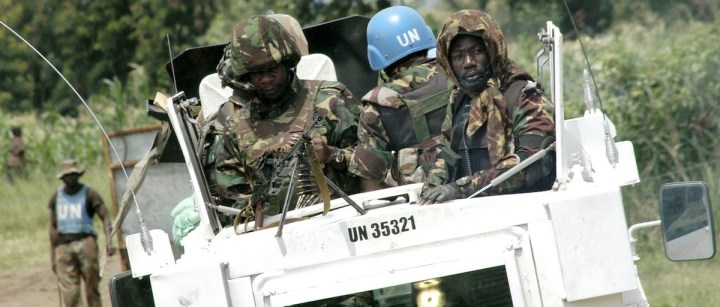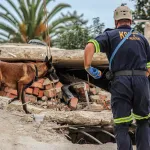MISSION OUT OF CONTROL
South African soldiers and their UN special force in eastern DRC have gone off track

After initial successes in eastern DRC, the UN’s Force Intervention Brigade – which has a mandate to hunt down and ‘neutralise’ rebels – has lately become better known for running local brothels.
After its early victories, the Force Intervention Brigade seems to have lost its sense of mission.
The detention of eight South African soldiers by the UN for “sexual exploitation and abuse” – including running brothels – in eastern Democratic Republic of Congo (DRC) last month was an ignominious chapter in a story that had started so well.
Between 2015 and 2019, 28 charges of sexual exploitation and abuse were laid against SANDF soldiers in the DRC, according to a University of Pretoria study.
All these soldiers were members of the Force Intervention Brigade (FIB), comprising battalions from South Africa, Tanzania and Malawi, which arrived in the eastern DRC late in 2013.
It was a special unit, with a more robust and aggressive mandate than the wider UN peacekeeping mission, Monusco. FIB’s mission was to actively hunt down and “neutralise” the many armed rebel groups terrorising local civilians. And it immediately began doing that, playing a decisive role in helping the Congo military, FARDC, rout the Rwanda-backed M23 rebels.
It had been the capture by the M23 of Goma, capital of North Kivu province, the year before that jolted the international community into establishing the FIB.
The SA National Defence Force contingent of about 1,000 troops in the FIB played a key role in the fight against the M23, in part by effectively deploying its Rooivalk attack helicopters.
The force cleared the M23 out of Goma and its surroundings in a week and then surrounded it and drove it from its other bases further north in North Kivu in just four days.
There were inevitable costs. On 28 August 2013, one Tanzanian FIB soldier was killed and three Tanzanians and two South Africans were wounded in an M23 mortar attack at Kibati, near Goma. Another Tanzanian died of his wounds on 18 September 2013.
On 27 October 2013 another Tanzanian soldier was killed in a fight between the M23 and the combined South African and Tanzanian quick reaction forces also near Kibati.
Since that decisive initial victory against the M23, though, the story of the FIB has become far more ambiguous, with mixed success against other armed groups.
The FIB has done quite well against one or two other rebel forces, including a successful engagement by the SANDF contingent against the Alliance of Patriots for a Free and Sovereign Congo (APCLS) rebels at Kitchanga in May 2014.
The FIB and the SANDF, in particular, were praised by Monusco for an earlier engagement on 30 April near the town of Nyabiondo, when three South African soldiers were wounded, three FARDC soldiers killed and three wounded repelling an APCLS attack.
Monusco command particularly commended the SANDF infantry for taking more than 1,500 civilians into their base to protect them from the rebels.
However, on 18 December 2016, Mai Mai militia attacked a small South African detachment at Butembo, killing Rifleman Moalosi Albert Mokhothu and wounding two other South Africans. Four Mai Mai were killed and two captured.
But the biggest challenge to the FIB has definitely come from the Allied Democratic Forces (ADF), a group that originated in Uganda but under pressure from the Uganda military later crossed into the eastern DRC.
Brutal massacres of civilians
It then affiliated to Islamic State in 2019 and became notorious for its particularly brutal massacres of civilians. The wider Monusco force helped the FARDC in its big offensive against the ADF in March 2014 in the Beni-Kamango area near the Ugandan border.
The FIB was rated largely successful in destroying ADF bases in that operation. But the ADF then demonstrated what was to become its general modus operandi – to discourage such attacks by massively retaliating against civilians, UN officials and humanitarian aid workers.
Since then, the ADF has continued to attack the FIB, inflicting some casualties among South African soldiers. On 3 September 2018, rebels, assumed to be from the ADF, attacked South African troops at Ngadi in the Beni area, wounding two and damaging a South African Air Force Oryx helicopter with gunfire.
And on 5 February 2023, South African Air Force flight engineer Sergeant Vusi Mabena died of wounds received from ground fire aimed at his Oryx helicopter. The aircraft commander, Major Omolemo Matlapang, suffered a serious shoulder wound.
An October 2019 Mail & Guardian report quoted an SANDF source as saying that 28 SANDF soldiers had died in the DRC, three of them in combat. Since then, Mabena was killed.
One of the non-combat fatalities was that of Private Nomathemba Ngeleka, who was murdered by a fellow soldier who then unsuccessfully tried to take his own life on 27 October 2017.
South Africa’s combat casualties have been significantly lower than those of the Tanzanians and Malawians in the FIB.
On 7 December 2017, suspected ADF rebels conducted a large and coordinated attack on Monusco at Semuliki in Beni territory, North Kivu, killing 14 Tanzanian peacekeepers and five FARDC personnel.
And on 14 November 2018, six Malawian soldiers in the FIB were killed and three went missing in a combined offensive by the FIB and FARDC against the ADF in Beni.
Despite these high casualties, ADF attacks on civilians did not abate, and the commitment of both FARDC and the FIB to take them on began to wane, fuelling local fury.
Teddy Muhindo Kataliko, president of Civil Society in Beni Territory, told Al Jazeera in 2018, “the population feels there is no will from Monusco to help them”. He said the ADF only had about 200 men. “And a national and international army together can’t get rid of them? It’s ridiculous.”
As far back as 16 December 2014, after the ADF had reportedly killed at least 184 civilians and wounded many others in attacks on villages in Beni since September, Human Rights Watch’s senior Congo researcher Ida Sawyer rebuked both the UN and Congolese forces, saying they “need to urgently coordinate their efforts and improve protection of civilians in Beni”.
Then Monusco head Martin Kobler essentially blamed FARDC, saying the UN could only act with FARDC, but FARDC had shown “little appetite” to fight the ADF.
In response to the increasingly vicious ADF attacks, the lack of coordination with FARDC and the ADF’s reprisals against civilians for its attacks, the FIB essentially stopped attacking the ADF in October 2019, which aggravated criticism.
Beefed-up quick response forces
The UN decided to restructure the force, adding troops from Kenya and Nepal and putting the operational focus on responding to rebel attacks with beefed-up quick response forces and better intelligence, rather than initiating attacks on the ADF and other forces and provoking reprisals.
But the restructuring does not seem to have greatly improved protection of Congolese civilians and popular protests against Monusco and the FIB have continued. The intervention of a military force from the East African Community also seems to have had little impact.
The future of the FIB has become uncertain. This week, SADC leaders held a virtual summit to finalise plans to deploy a purely SADC intervention force in the eastern DRC – to be called SAMIDRC – to protect civilians and in part to stabilise the territory to enable the population to participate in presidential elections on 20 December.
Though it is not clear, there are suggestions that the SADC elements of the FIB could be rehatted to constitute the new SAMIDRC. The SADC leaders were due to reconvene in person on Saturday, 4 November, to continue their deliberations on how to finance and operationalise SAMIDRC.
Why SAMIDRC would make a difference has not yet been made clear. DM
This story first appeared in our weekly Daily Maverick 168 newspaper, which is available countrywide for R29.



















 Become an Insider
Become an Insider
Comments - Please login in order to comment.